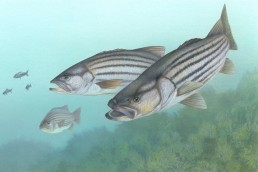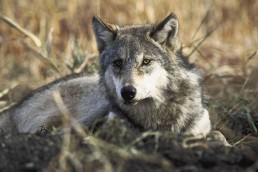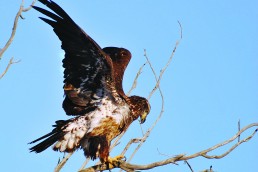Nature Notes
SHARE THIS POST
Earning their stripes
For fishermen across the country, there is a place famed for its phenomenal striped bass fishing. The one and only Montauk Point State Park is on the bucket list for many. While Montauk steals the limelight, many states throughout the U.S. do have monster stripers. In fact, within the Midwest only Minnesota, South Dakota, and Michigan do not have striped bass. The bass have an ability to adjust to freshwater and coldwater bodies of water and their larger size makes them a perfect gamefish for anyone looking for a fight. A unique fact about oceangoing striped bass is that they are anadromous fish, which means they are born in freshwater and return for the spawn, but live mostly in saltwater their lives. But the striper’s ability to survive solely in freshwater was first discovered when dams were built on South Carolina’s rivers and the fish were trapped upstream. The stripers above the dam thrived, so the local wildlife agencies began releasing them in other lakes. Not everyone may know their state contains these fantastic fighters, but once dialed in, they’re a ton of fun. Finding your state’s own “Montauk Point” might just be a matter of wetting a line.
‘Jellyfishing’ anyone?
Invasive species are everywhere, and some are even managed on purpose for reasons such as hunting and fishing. Many invasive species never receive special attention, either because they are not very detrimental to the environment or not deemed interesting. One of these is an invasive from the Yangtze River in China. But Craspedacusta sowberii is known as a freshwater jellyfish. That’s right—here within our own lakes and rivers, jellyfish can be found. Excluding Alaska, the Dakotas, Montana and Wyoming, jellyfish can be found all throughout the U.S. This species of jellyfish is considered harmless, unless of course you’re zooplankton. Sightings of these freshwater jellyfish were first documented in the early 1900s, and one explanation believed is through the transportation of plants and fish from China, with the water hyacinth being the primary suspect. And while these jellyfish are not supposed to be here, as far as experts can tell, they do not have a large negative impact on our ecosystems and are just another interesting critter to be found, if you can, in the Midwest.
A dangerous worm
The Canadian moose has taken a substantial population hit in recent years. While no single reason has been pinpointed, multiple factors are being investigated. Disease is currently in the spotlight, and specifically a parasite called “brainworm” has been put under the microscope. Brainworm can be very common among white-tailed deer populations. But because of the deer’s resistance to infection, the parasite isn’t a reckless killer. However, since moose have weaker resistance to the parasite, it is often fatal. Often, a host can carry it for years, which only increases the amount it spreads. The brainworm’s method of transmission is very complex, even involving other species. It starts with an already infected moose. An adult parasite lays its eggs inside the animal’s brain. When the eggs hatch the larval worms enter the bloodstream, slowly creeping into the lungs and then the throat, which then transports them to the stomach. In the stomach, they get passed with the rest of the animal’s waste, covering the feces in a mucus coat. Eventually, some species of gastropod will come along and eat the feces, making themselves a vector. By an unlucky series of events, the infected gastropod will crawl up onto vegetation for food only to be eaten by a large mammal. Obviously, not every infected gastropod is eaten, but enough are for it to be a serious problem believed to be decimating our moose populations.
Are you enjoying this post?
You can be among the first to get the latest info on where to go, what to use and how to use it!
Blame it on the rain
With fall upon us, it’s no secret that wildlife is moving, or has already moved. We tend to think of avian species as the major migrators, but smaller animals can be found moving right in our own backyards. Every fall, a huge movement of amphibians can be seen during rainy nights. Amphibians may not move far compared to other animals, but it is essential for them to reach hibernation grounds. On some nights thousands of salamanders can be seen moving around. Unfortunately, with so many crossing the roads, many fatalities can occur. When warm rains come in the spring, large migrations of amphibians occur again, but this time for breeding purposes. It’s important to remember to lookout for these amazing woodland creatures and try to avoid known migration routes or anytime when you see roads covered with amphibians. Use an alternate route. Of course, Google Maps or others can tell you.
Not-so-easy pickin’s
Spring morels get a lot more attention than the wealth of other edible mushrooms available later in autumn. The good part for serious ‘shroomers is the lack of human competition in the woods. One underappreciated but delicious mushroom is the black trumpet. These are an example of “don’t judge a book by its cover.” They look almost sinister—inky, black and tuberous. Stacked up to other mushroom species, black trumpets are small, standing around 3 inches at most. One could compare them to a flower in shape: narrow at the base, widening at the top and hollow. Even though there are multiple species, most are dark brown, gray or black. Because of their dark color, you can’t just traipse through the woods, scanning well in front of you. You must look closer to the ground and around fallen branches and water runoff areas. When black trumpets are located in the fallen leaf litter you can easily step on them, especially since their appearance is identical to a dead leaf. As winter approaches and temperatures get frigid, the mushrooms start to disappear for the year so if anyone is looking for a mushroom-based meal you better act fast. It’s a shame how many mushrooms go unpicked each year.
Split-personality trees
In the world of natural history, “deciduous” and “coniferous” are often mentioned. But what exactly places a tree into one of the categories, especially when you have trees like tamarack, which shed their needles like leaves? It comes down to what’s on their branches, what seed mechanisms they use and their shedding cycles. Trees in the coniferous group are usually the pine trees. Pines use cones to hold and protect their seeds. Also, they have needles that don’t shed in the fall like deciduous trees, though there are exceptions. Pine needles are a way of preserving water, while leaves do not retain water very well. That’s why pines tend to grow in rockier and drier places. Deciduous trees can be classified by having leaves, a seed that is not a pinecone and one that drops its leaves in the fall. With everything in nature there are exceptions, and the two are the tamarack and the larch. Both trees drop their yellowing needles in the fall, making them a deciduous conifer. But other than dropping needles, they have more in common with coniferous trees. So much for the Laws of Nature.
MWO
SHARE THIS POST
Did you enjoy this post?
You can be among the first to get the latest info on where to go, what to use and how to use it!
Calvin Vick
MidWest Outdoors’ “Nature Notes” columnist Calvin Vick is an undergraduate studying biology, with an emphasis on herpetology, at the University of Central Arkansas. His primary interests are venomous snakes and salamanders. He spends most of his free time photographing the two.



